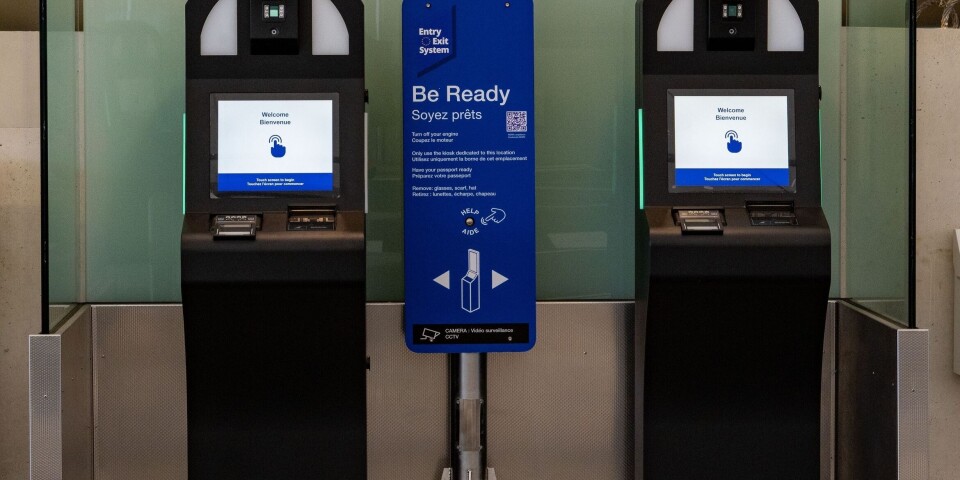Full details on how the EES will be implemented at all French Schengen-area borders have not been released, though the system is set to launch on October 12 and will be operational in some form at most French borders from this date.
We have compiled below details of what is known for France, and previous questions asked by our readers on the topic can be found in our article here.
The scheme has been a long time coming - the EU adopted regulations for the European Entry/Exit System (EES) in 2017 after around a decade of prior planning - but all the French border points where it will apply from Sunday October 12 have not yet been confirmed.
Notably it is not known whether it is set to start immediately at any ferry ports other than Calais and Dover.
The Interior Ministry reports, however, that the country is set to make full use of the right to start gradually.
Who is eligible for EES?
‘Eligible’ travellers are those who are not citizens of the EU, EEA, or Switzerland and who are in France for a short stay - either under the 90/180-day visa-free rule (for example, Britons and Americans) or with a short-stay Schengen visa (for nationals who require one, such as Russians, Chinese, or Indians).
All eligible people travelling into France from Sunday from a non-Schengen country or who is leaving France/Schengen to go to a non-Schengen country must therefore be prepared and expect border formalities to take longer (so, arrive in good time) and do not be surprised if asked to have a facial image and fingerprint scan taken.
See below about ‘travel questions’ and for documents it is preferable to have to hand, such as Ghic/Ehic card, hotel booking, French-home utility or property tax bill or email/letter from a host inviting you to stay. Note, though, that it is not certain you will be asked to show these and the official rules on these have not changed due to EES.
France was required to provide the European Commission with details of its roll-out plan by September 24, but this is not publicly available.
The Interior Ministry said: "In France, the vast majority of border crossing points (including the port of Dover, London St Pancras station, and Eurotunnel in Folkestone) will begin using EES on a small scale between 14:00 and 16:00 for a few travellers, with or without biometric data collection.
"Therefore, nothing particularly noticeable is expected on October 12.
"The technological measures designed to speed up the process [ie. pre-registration kiosks and tablets] will be gradually activated over the coming weeks; they will not be necessary in the early days given the low volume of travelers who will be registered in EES and the lack of any visible effect on screening times."
EES will start in a ‘phased’ way - what does this mean?
Use will be made of the right – created by new EU regulations adopted this summer – to ‘phase in’ EES over a six-month period.
Interior Ministry officials previously told The Connexion: “France will implement the phased approach from the first day that EES comes into service.
“During this six-month period, France will begin to activate EES gradually across a wide range of airports, ports, and international train stations.
“Some sites will be affected from October 12. Discussions have been taking place between government departments and each border infrastructure manager.
“The details of the gradual implementation will be specific to each border crossing point, depending on its particular characteristics. Each site has its own ramp-up plan, discussed with government departments.”
EU rules on the ‘phased’ (or ‘progressive’) start state:
From October 12, EES checks must be done at at least one border crossing point in a country and after one month at least 10% of relevant passenger crossings at that country’s borders should be logged.
First 60 days: states may run EES without facial image/fingerprint collection.
After three months: EES should be fully in place at half or more crossing points and for 35%+ of all relevant passengers.
Manual passport stamping will continue during the phasing-in period and end afterwards as EES will track entries and exits and respect of the 90/180 days rule. During ‘phasing in’, border guards will continue to check stamps.
States may fully or partially suspend operating EES at certain border crossings in exceptional circumstances (for instance when traffic intensity would lead to very high waiting times).
In France ‘Schengen border crossing points’ refers to 70 airports, 30 ports and half a dozen stations, including where French checks are done at London St Pancras station for Eurostar and near Folkestone for Eurotunnel passengers.
‘Phasing in’ can mean several things, and some or all of these could apply at specific French border crossing points:
Only certain groups of eligible passengers will be entered into EES from October 12 with others at a later date (eg. coach passengers first, car passengers later)
Only some passengers and not others will be entered initially (for example, one in ten on October 12 and gradually increasing to all eligible passengers from later dates)
Only some border crossing points will start operating the system from October 12, and others will follow over the first six months.
What is known for sure?
Many large crossing points will use ‘pre-registration’ where passengers will be strongly encouraged to use kiosks to enter in much of the required information before they arrive at the actual border guard’s booth, thus saving time.
Some places will instead use tablet computers, handed to people by helpers.
Some other smaller crossing points will have neither and everything will be done at the border guard’s booth.
Some further information is available for certain border crossing points. We detail below what has been passed on to us.
Port of Dover (France bound)
EES will operate from October 12, but initially only for lorry drivers and coaches.
All other passengers, including those coming by car or on motorbikes, or on foot with P&O, will be subject to it a few weeks later, from November 1.
Dover will have kiosks - people will have to get out of vehicles to use them in specific areas - and is not using tablets.
British coach firms’ organisation CPT is reported as saying the port advised them to arrive three hours before sailing time as opposed to two hours previously.
Another major UK organisation for coach and lorry drivers, RHA, expressed concerns about increased checking of the 90/180 days rule that will result from EES, calling for an exemption for Britons who drive professionally.
Port of Calais (UK bound)
From October 12 EES will affect all lorry drivers, who will be registered in EES at the point at which they pass the border guard’s booth.
From October 12 it will also affect some coaches – only 10-20% at first then gradually increasing.
Selected coaches will be directed to an area where passengers will need to get off the coach and use kiosks to pre-register in a dedicated building (the same building as already used for border checks for coaches), before the coach then travels on to the border.
Travellers in cars will start to be checked later, probably in November.
After having passed their check-in with the ferry company and before they pass the border guard’s booth, an agent with a tablet computer will come to the car for their pre-registration. They will not need to go to a specific area and will not need to get out of the car.
Eurostar
Passengers using Eurostar (France-bound at London St Pancras, UK-bound at Paris Gare du Nord) may be registered into EES from October 12, but Eurostar states that at first “only select routes and passenger groups” will be asked to pre-register at kiosks, while the current, familiar process will continue for others.
Over six months EES registration will be expanded to all eligible travellers. Eurostar hopes this will cause “minimal disruption to check-in times and operations”.
Alongside the other elements of EES registration, it was initially thought passengers would have to answer a set of questions about travel plans.
Eurostar says it has now decided not to require this during phasing in and will review this element during the next six months.
See below for more about these travel questions.
Eurotunnel
Eurotunnel parent company Getlink stated that the firm will begin registering coach passengers from October 12 as well as commercial (freight) traffic. Passenger vehicles will follow “a few weeks later”.
A spokeswoman said: “At our terminals, the travel questions are not included on the kiosk screens, allowing our EES process to remain quick, simple, and efficient for travellers. The decision to ask specific questions is left to the discretion of the border officer at the booth.”
Airports
The general delegate of French airports organisation UAF, Nicolas Paulissen, said they expect that all French airports will be bringing in EES from October 12 for some passengers, but with different choices and rules as to phasing-in plans.
He said the time taken to process each passenger will get longer as a result so there will be increased waiting times even where kiosks are available, though perhaps not at first in places where only a small number of people are registered.
However, he expects waiting times to eventually reduce again in future as fewer people need to be registered in EES for the first time.
“We will be doing our best to limit it as much as possible.”
He said this will also depend partly on the successful integration of the EES processes and use of automatic Parafe passport e-gates at those large airports where they exist.
The Interior Ministry says this integration will be possible for subsequent (not first) entry/exit after EES starts, for visitors from many countries.
However, France was reportedly still working on a technical solution to allow non-EU nationals who live in France with long-stay visas/residency cards to continue to use these gates.
What ‘travel questions’ might be asked?
It had been expected that some travel hubs would take advantage of EES to formalise the asking of ‘travel questions’, via the use of the EES kiosks and tablets. However, rules relating to this have not officially changed with the arrival of EES.
Several such questions may be asked by guards at Schengen borders in theory, according to the Schengen Borders Code, but they rarely have been.
The Interior Ministry said 'travel questions' can be activated or deactived on the machines by the border guards. If they are deactivated the guard may ask the questions at the border if they choose to do so and may ask for proof (as was already the case).
Eurostar previously told us its kiosks were expected, on a traveller’s first registration only, to ask about intended length of stay, purpose of travel (eg. tourism, business, study…), country of first stay in the Schengen area and confirmation of having sufficient means of subsistence.
However a trial version of the Eurostar machines, demonstrated on a social media video recently by a UK journalist, was shown to ask the following questions and to state that travellers may be asked to provide proof:
What is your situation? (eg. EU citizen, visa, residency permit, other)
Do you have proof of accommodation? (eg. hotel booking, accommodation certificate) – to which it was possible to answer ‘yes’, ‘no’, or ‘don't know’
Do you have a return ticket?
Do you have sufficient means to cover your stay (credit cards etc)?
Do you have medical insurance?
The kiosk then invited the user to ‘prepare your documents and certificates and go to a border checkpoint’
The Schengen border rules require either a return ticket or the means to buy one. Another requirement is to have a valid passport issued within the previous 10 years and valid at least three months after the intended date of departure (or six months if this is unclear).
Medical insurance for visitors is an existing French rather than EU rule, France accepts a Ghic/Ehic card as sufficient for visitors from the UK but the UK government also recommends additional travel health insurance so as to cover all eventualities.
As for proof of accommodation, which can be asked for under the Schengen Borders Code, the Interior Ministry previously told us it is not essential for visa-waiver visitors staying with friends or family to have an attestation d’accueil from their host’s mairie.
If asked for proof, officials confirmed that they could show a written invitation from their host (formal attestations are required by visitors who need a short-stay visa to come to visit France).
However, in this case, we were told, the visitor should have more money at their disposal, the official amount being €120/day, as opposed to €32.50 with the formal attestation (see brexit.gouv.fr). People with hotel bookings are expected to have at least €65/day.
The borders code says guards can make an assessment of the ‘sufficient means’ by looking at items such as cash, travellers’ cheques and credit cards in the person's possession.
How will new EU border changes affect you?
Connexion subscribers can read our help guide to the EES and Etias for free on the Subscriber Resources page here.
If you are not subscribed to the Connexion either click here to subscribe or click here to purchase the guide for €9.50.




























